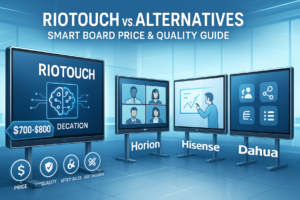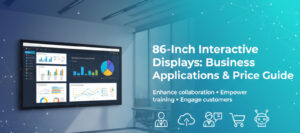We are entering the age of artificial intelligence, where everything seems to be accelerating. From cars to smartphones, nearly every industry is finding ways to integrate AI into its products. As an interactive display manufacturer, we clearly see that interactive display technology and AI are deeply connected. Smart boards are no longer just about touch control—they are evolving into intelligent collaboration tools powered by data and algorithms. In this article, I want to share with you everything about AI-driven interactive displays: what makes them different, what features they bring, and how they are transforming classrooms and business meetings in the AI era. Let’s explore how this technology is reshaping the way we teach, present, and communicate.

Definition and Evolution of AI-Driven Interactive Displays
Since the global adoption of ChatGPT in late 2022, artificial intelligence has rapidly transformed nearly every industry, accelerating innovation across education and business technology. Within this wave, the AI-driven interactive display has emerged as one of the most representative smart devices bridging human interaction and machine intelligence.
An AI-driven interactive display refers to a next-generation smart terminal that combines AI algorithms, voice recognition, visual recognition, and content generation technologies. Beyond traditional touch, writing, and screen-sharing functions, it can now analyze user behavior, provide intelligent recommendations, enable voice commands, perform real-time translation, generate content summaries, and support face or gesture recognition.
Earlier generations of interactive displays focused mainly on “input and display”, relying on touch chips and handwriting algorithms. However, the integration of AI has elevated them to a new level of “understanding and learning.” For example, AI-enabled smart boards can automatically generate lesson materials, summarize meeting notes, recognize speakers, and adjust display parameters dynamically for different environments.
The evolution from traditional touchscreens to AI-powered interactive displays represents not only an improvement in hardware performance but also a shift in interaction logic—from humans adapting to machines, to machines understanding human behavior. This transformation positions interactive displays as a key entry point for intelligent education and business collaboration in the AI era.
Core Feature 1: Intelligent Recognition and Voice Interaction
In AI-driven interactive displays, intelligent recognition and voice interaction stand out as one of the most transformative innovations. In the past, users had to manually touch the screen to perform actions. Today, with just a simple voice command, the display can understand and execute instructions instantly. Powered by advanced natural language processing (NLP) et speech recognition algorithms, users can now interact with the device using everyday conversational language—no rigid commands required. It feels almost like Tony Stark speaking to “JARVIS” in Iron Man—say “open the whiteboard” or “play the previous video,” and the system responds immediately.
The AI voice assistant has become a powerful tool for improving efficiency in classrooms and meetings. In educational settings, teachers can switch slides, enlarge key content, or access teaching materials through voice commands without interrupting their lecture. For example, when a teacher says, “show the photosynthesis experiment video,” the system automatically searches and plays the relevant clip, creating a smoother and more engaging learning experience.
In business meetings, presenters can start note-taking, initiate video calls, or adjust display settings using simple voice prompts, achieving touch-free control. This kind of interaction marks a major leap forward in human-computer communication—AI not only “recognizes commands” but also understands intent, providing a smarter, faster, and more humanized experience.
Core Feature 2: AI Content Generation and Smart Recommendation
Another defining capability of AI-driven interactive displays is AI content generation and smart recommendation. This feature enables the device to automatically create or organize digital materials—such as lesson slides, meeting notes, or presentation summaries—saving users significant time and effort. By integrating advanced natural language generation (NLG) and contextual learning algorithms, the display can interpret key information from documents, discussions, or visual data and produce structured outputs like PPT summaries, whiteboard outlines, or action lists.
For educators, this means the system can automatically generate a teaching outline or exercise sheet based on past lessons or uploaded materials. For example, after finishing a lecture on climate change, a teacher can simply say “create a quiz for today’s topic,” and the AI instantly compiles relevant questions and images from its knowledge base. Similarly, during a business meeting, the display can record key points through speech recognition and generate a clear meeting summary or follow-up list, complete with task assignments.
Beyond generation, the AI engine also learns from user habits and preferences to provide personalized recommendations. It might suggest relevant case studies, visual charts, or recent industry updates for a presentation, or recommend interactive simulations for a science class. In essence, AI transforms the display from a passive tool into an active, intelligent assistant—one that not only responds but anticipates what users need next, enhancing both productivity and creativity in every session.
Core Feature 3: Image Recognition and Facial Detection
AI-driven interactive displays are equipped with advanced image recognition and facial detection technologies that bring a new level of intelligence to classrooms and workplaces. Using built-in cameras and deep-learning algorithms, these systems can identify faces, track body posture, and even detect emotional expressions in real time.
In educational settings, facial recognition helps automate attendance tracking. When students enter the classroom, the system can instantly verify their identities, record attendance, and synchronize the data to the school’s management platform—eliminating manual sign-ins. Beyond attendance, posture detection can identify whether a student is focused or distracted, while emotion analysis provides teachers with insights into classroom engagement, helping them adjust teaching strategies dynamically.
In business environments, this technology enhances security management and personalized experiences. Meeting rooms can automatically recognize authorized participants, unlock the display, and load customized profiles or previous session data. For high-security areas, facial recognition ensures that only verified personnel can access sensitive presentations or data.
Furthermore, these features enable more humanized interaction—for example, the display can automatically adjust brightness or content layout based on the user’s position and expression. This combination of visual intelligence and real-time response transforms the smart board into a truly adaptive system that understands its users, promoting both safety and personalized engagement.
Core Feature 4: Data Analytics and Learning Behavior Tracking
One of the most valuable advantages of AI-driven interactive displays lies in their ability to perform data analytics and learning behavior tracking. Unlike traditional displays that only serve as a presentation tool, AI-enabled smart boards continuously collect, analyze, and visualize interaction data in real time. Through built-in sensors, usage logs, and AI analytics engines, the system can monitor user engagement, participation frequency, content interaction, and time spent on specific topics.
In education, this means teachers gain access to data-driven insights about student performance. For example, after a class session, the AI dashboard might show which students interacted most with the board, which topics triggered confusion, and how much time was spent on each lesson segment. Based on these analytics, the system automatically generates visual reports that help educators identify learning gaps, optimize future lessons, and provide personalized feedback.
In corporate environments, the same principle applies to meeting analytics and productivity tracking. The display can summarize speaking time, record collaborative inputs, and generate post-meeting performance reports. For instance, after a project briefing, managers can review participation heatmaps, identify inactive departments, and make data-backed decisions to improve communication flow.
By transforming interaction data into actionable intelligence, AI-driven displays shift from passive tools to decision-support systems, empowering educators and executives to make smarter, faster, and more informed choices for continuous improvement.
Core Feature 5: Smart Connectivity and Ecosystem Integration
The most forward-looking aspect of AI-driven interactive displays is their ability to achieve smart connectivity and ecosystem integration. Modern smart boards are no longer isolated devices — they act as central hubs that connect seamlessly with cloud platforms and third-party collaboration tools such as OpenAI, Google Workspace, and Microsoft Teams. This integration allows users to access AI resources, documents, and communication channels directly from the display interface, eliminating the need for multiple devices.
For example, a teacher can instantly open Google Docs on the board to edit class notes, invite students via Teams for real-time collaboration, and use OpenAI tools to summarize complex topics or generate exercises. Similarly, in a corporate setting, team members can co-edit presentations, conduct video conferences, and brainstorm on a shared digital whiteboard — all synchronized across laptops, tablets, and cloud servers.
This cross-device and cloud-based collaboration greatly enhances workflow efficiency. Meeting notes, annotations, and AI-generated insights are automatically saved and accessible from any connected device, ensuring no valuable information is lost. Moreover, IT administrators can manage updates, permissions, and cloud storage from a unified control center, simplifying maintenance and security.
In essence, smart connectivity transforms interactive displays into an intelligent collaboration ecosystem — one that merges AI assistance, cloud integration, and multi-platform compatibility to deliver seamless communication, higher productivity, and a truly interconnected digital workspace.





